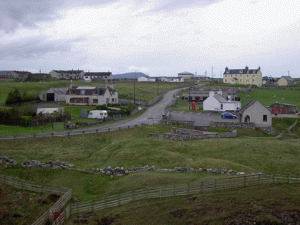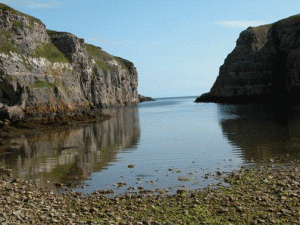
Mackay Country
Dùthaich Mhic Aoidh
An area in North-West Scotland of natural unspoiled beauty, rich in heritage & history
Smoo Cave

Smoo Cave Tours
operated by
Colin Coventry
smoocavetours.weebly.com
The word Smoo is a Norse word “Sumvya”(Smjuga) meaning creek or cleft. The largest entrance limestone cave in Britain lies east of Durness village, at the end of an eight hundred metre sea inlet; Geodha Smoo; where the Smoo burn drops from the level of the road underground. Alt Smoo flowing off the moors drops nearly twenty five metres into the second chamber down a vertical shaft the Falais Smoo or Chimney Smoo as the sink hole in the roof is called. The falling stream strikes a rock about three metres above the water surface before disappearing in a shining apron of scattered silver in a deep pool with a depth around eight metres. After hard rain, the Alt Smoo is changed into a raging torrent that crashes into the underground lochan with a gigantic roar.
The cave is approached by a steep track down to the inlet where the sea water meets the river after flowing from the fall through two chambers of the cave. The cave opens as a large cavern in the lime stone cliffs over sixty metres long, forty metres wide and an entrance arch over fifteen metres high. The second chamber has become accessible by a wooden bridge over a rock wall and Smoo burn.
This second cavern is about twenty one metres by nine metres with two openings in the roof. For the slightly adventurous by descending a ladder, approximately two metres, to a small dinghy the third chamber can be accessible. Able to carry six persons across a deep pool into which the water from Smoo Burn falls from one of the roof holes, about thirty seven metres wide. Being dark brown the chamber is not particularly impressive. The waterfall dictates when this excursion is possible as at times the water can be falling too hard to allow a safe passage. The “blow hole” and waterfall can be observed from the top of the cave from an observation point.





The stream dissolving the limestone has produced the cave and Dolomite working along the lines of weakness in the rock e.g. fault joints, and enlarging them. The hole down which the stream flows has been formed by the solution of the rocks where they are faulted. The isolated blocks of rock outside the main chamber and in the long narrow sea inlet are remnants of pillars which once supported caverns like the present one but have since collapsed. It has been stated the inlet was created as the cave roof progressively collapsed deepening the cavern. At times of high tides, the sea laps the back wall of the cave. The process is continuing and eventually Smoo Cave will collapse and the sea inlet will advance a little further inland. The ground level in the cave has risen over the years and the sea tide has altered course. It is likely that further cave systems exist in the vicinity with passages extending underground for some considerable distance.


On more than one occasion, archaeological digs have shown signs that Smoo Cave has been used for fishing and living in for thousands of years. Samples have been obtained from the ancient midden estimated to be about seven thousand years old at the entrance. It is full of discarded shell fish and bits of animal bones dated to different periods showing the cave has been used at altered times. The most recent excavations were conducted by archaeologists from Glasgow University Archaeological Research Division and the Highland Council in 1992 and 1995. These were the first systematic archaeological investigations. Other references to exploration are from Ordinance Survey records and there is a small entry in Discovery and Excavation in Scotland by Keillar 1972.
In 1992, investigations of an eroding shell midden were carried out prior to the construction of a protective wall. This work involved cutting back, sampling and recording of the eroding section. This resulted in the identification of several occupation and activity horizons. The shell midden, the earliest phases of which appeared to be Iron Age , represented the latest phase of activity. The earliest deposits substantially lower than the present cave floor may represent Mesolithic activity. The investigation revealed further sites and deposits located close by. The conclusions to the report on the investigation reveal the cave to hold a valuable source of evidence of multi-period occupation. The work was a major contribution to the possible identification of the most northerly site of Mesolithic activity in mainland Scotland.
In 1995 Historic Scotland commissioned Glasgow University Archaeological Research Division to preserve by record the Archaeological deposits contained within two marine caves situated within the western wall of the inlet Geodha Smoo . At some point in the distant past, it is considered these existed as side chambers within the main cavern but are now separate, opening out from the cliff walls of the Geodha. This work was carried out over a four week period by a team of four archaeologists before deposits were lost in their entirety to marine erosion and the sea. Cursory investigation of a third cave located on higher ground opposite on the east side of the inlet revealed evidence of prehistoric use. The excavations resulted in the recovery of a large number of samples, valuable artefactual and environmental evidence, the identification of complex archaeological deposits, data and scientific reports.
The first inhabitants of Durness very probably used the cave for shelter. There are vague stories, likely based on some fact, of the cave being smugglers’ hideaway and linked with tales of the supernatural. It was formally believed to be the abode of spirits who guarded this entrance to the nether world. The first Lord of Reay met with the Devil on several occasions and was able to get the better of him. The Prince of Darkness was none too pleased about this and followed Donald Mackay to Durness where he sought to waylay him in Smoo Cave . Lord Reay was heading for the cavern just before dawn but had the good fortune to send his dog into the blackness in front of him. When the animal came out howling and hairless the master of Reay realised what lay in store for him. He held back for a moment and in that moment the sun rose. In the light of day, the Devil was powerless and left through the roof of the cave leaving the three holes seen today.


In addition to inspiring myth and legend a dig in 1904 was recalled by Donald Macdonald of Sangomore in 1986 of which no record could be found but he remembers that a number of bones were discovered. A mound was also detected thought to be a kitchen from when the cave was used for a dwelling. Mr. Ian Keillar from Elgin uncovered human bones and a worked stone which had been exposed by the action of the burn on the sandy cave floor. These were found to be from the Mesolithic period.
The cave was used as a store for the 18th Century Orkney merchant builder of Smoo lodge. He is also reputed to have built the small limestone block hut at the foot of the path. This house is roofless but is a sturdy building.
In 1991, floodlights were installed. These have been well concealed to give a dramatic and clear illumination of the cave and can now be explored without torches and candles. In 1860, a traveller reported the possibility of being ferried across the inner pool but to do this boatmen must be engaged who charge fifteen shillings and another charge for lights.
The rocky slopes around the cave are usually abundant with stone graffiti left as a reminder by tourists and a token of a visit. In 1989, Smoo Cave was denotified as a Site of Special Scientific Interest



In the diary of Sir Walter Scott for the 19th September 1814 there is a covering description of his visit to the cave and he notes the effects of his lamp on the dew covered stalactites as,
“The effect of ten thousand birthday candles. The cave was covered with stalactites and stalagmites. A water kelpie or an evil spirit of aquatic propensities could not have chosen a fitter abode and to say the truth I believe at our first entrance and all our feelings were afloat at the marvelling of the scene the unexpected splashing of a seal would have routed the whole dozen of us. Impossible for description to explain the impression made by so strange a place.”